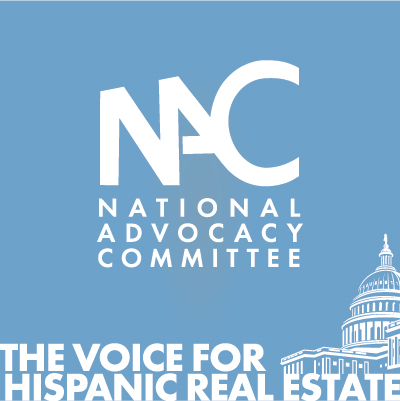Emerging Opportunities in Home Building
Celebrating NAHREP familia, cultura, politics, and grassroots action
June 30, 2022
Qué onda mi gente?!
As you know, NAHREP, a 22-year-old organization, has a clear mission to advance sustainable Hispanic homeownership. NAHREP’s Policy Department, a wing of the organization that I started 4 years ago, is still a kid in comparison to the broader organization. But, like the organization, it is important that the department also has a clear mission statement. I would say that the NAHREP Policy Department’s mission is to advance sustainable Hispanic homeownership through advocacy, thought leadership, stakeholder relationships, research, and education.
Our role is not only to be a part of the policy-making but to also identify opportunities for our members as government programs are developed. For example, NAHREP was at the center of the conversations around Paycheck Protection Loans (PPP) loans, a business loan program established during the pandemic that provided low-interest, forgivable loans to small business owners and sole-proprietors. Our department worked hard to ensure our members understood the PPP program and applied for funding when applicable.
Similarly, I’ve been on the lookout lately for government programs that help builders of color. During our research for the State of Hispanic Homeownership Report, a trend emerged highlighting that real estate agents and brokers, faced with a lack of inventory for their clients, are increasingly taking on home building as a way to diversify their business portfolios. While we love that, I also want to make sure that our members have the right training and access to capital if they do decide to embark on the world of home building.

Emerging Opportunities in Home Building
Earlier this month, the Federal Housing Finance Agency (FHFA) announced the Equitable Housing Finance Plan. After carefully reviewing the proposals, a few things stood out in Freddie Mac’s proposal as noteworthy:
- Rehab loan funding
- Commitments to support developers of color
I encourage all of you to bring these topics up in your next NAHREP education event to become informed, share information, and take advantage of these programs. If you have additional questions, you can always email me for more information. Or, as these programs are specific to the Freddie Mac plan, reach out to your local Freddie Mac Regional Office.
Renovation Financing
Laurie Goodman from the Urban Institute, one of the top housing economists in the country, believes that the crisis we’re seeing with institutional investors buying up single-family homes is mostly driven by a broken rehabilitation funding system. Investors are purchasing run-down homes that first-time home buyers don’t have the capital to renovate. According to Freddie Mac, over 25 percent of affordable single-family homes nationwide require moderate or significant rehabilitation, and communities of color are more likely to live in neighborhoods that historically have suffered from undervaluation and underinvestment. A vast majority of renovations that require financing are funded using credit cards (22 percent), personal loans (39 percent), or home equity (22 percent). The solutions to address this issue would directly require the involvement of NAHREP members.
The Freddie Mac Plan offers a lot of opportunities for NAHREP members to engage. Freddie Mac will:
- Engage with community organizations and their lending and real estate partners (that’s us!) to understand and address challenges and barriers to utilizing existing renovation products.
- Focus on improving the housing stock in Majority-Minority Census Tracts (MMCT) and historically redlined communities that remain underserved.
- Promote the enhancement of existing housing stock in areas such as resiliency, energy efficiency, accessibility, ADU carve-outs, and other maintenance-related priorities.
- Expand partnerships among nonprofits, lenders, real estate professionals, and homebuyers to facilitate the acquisition and rehabilitation of city-owned properties in MMCTs and historically redlined communities that remain underserved.
Support for developers of color
Given the home building trends we’ve seen among our members, while at the same time being conscious of displacement in many historically Latino neighborhoods, I thought this was an interesting part of the plan. According to the plan:
“There is a need to preserve the housing stock for renters living in historically disinvested communities who are at risk of being pushed out of their neighborhoods due to gentrification and rising rent and home prices. An important aspect of addressing both challenges is increasing opportunities for members of the community to become developers in their own communities — building wealth while building communities.”
Develop the Developer (DTD): The plan would increase redevelopment activity by expanding education and financing opportunities for emerging minority and female developers. In 2020, Freddie Mac launched a similar program with a focus on single-family properties. They plan to extend the DTD curriculum to also target the building of 5+ unit buildings in underserved communities of color. The DTD program will bring seasoned multifamily partners to provide funding, industry knowledge, and advice to emerging developers (such as yourself). The program would be started in select markets and expanded over time.
When opportunities like these arise, it is important to not only become informed but also to develop relationships with the program leaders so that our members can be a part of those pilot programs. These programs need practitioners like you to be successful. Let’s engage with the regional offices and educate our members on these programs!
Un abrazo.

About Noerena Limón
Noerena Limón is NAHREP’s Executive Vice President of Public Policy and Industry Relations. Noerena heads the organization’s policy and advocacy efforts on issues ranging from homeownership, housing inventory, credit access and immigration.
Prior to joining NAHREP, Noerena spent six years at the Consumer Financial Protection Bureau (CFPB) and served as a political appointee under President Obama in the White House Office of Political Affairs.



